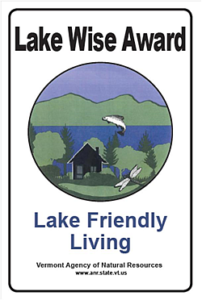The 2014 Vermont Shoreline Protection regulations offer guidelines that help diminish erosion of sediment into the lakes. Here are some basic guidelines:
- Plant native groundcover, shrubs and trees which stabilize the soils, prevent erosion, enhance privacy and provide cooling shade for the shallow water where fish and insects breed. The lake bottom provides habitat for many small creatures essential to a healthy lake.
- Plant native species that will provide stabilizing root structures to prevent erosion, habitat for insects, small mammals and birds. Plants such as ferns, blueberries and other low shrubs will provide all this and shade for the shallow water.
- Steps or paths to the water should ‘infiltrate’, or have a crushed stone base which allows water seep through. The route the path takes should not be a straight line down to the water, but rather should zigzag or meander to slow down the velocity of water runoff and give the water a chance to absorb into the soil.
- Prevent driveway runoff by having your driveway crowned regularly; by installing water bars for steep slopes, which divert driveway water flow to the side into a vegetated area for absorption; by remediating any water channels that form and flow directly into the lake; and by maintaining vegetative buffer strips along driveways. Plants slow runoff from the road and driveways and help to remove sediment and phosphorus before they reach lakes or stream
- Don’t cut trees down. Instead prune lower branches and thin out shrubs to open up or maintain partial views. Allowing some small trees to grow is recommended as eventually the large ones will need “replacing.” The spongy “duff” layer of decomposing leaves under trees and shrubs is also a very important aspect of filtering runoff and is why lawns don’t work as well as the natural forest floor.
- No beach is a good beach. Natural beaches are rare in Vermont! Adding sand or other fill puts phosphorus into the lakes and suffocates the natural bottom habitat. Also, sand which is not stabilized by vegetation washes into the lakes.
- Minimize artificial structures. Minimize construction of piers, breakwaters, retaining walls, etc., which alter the natural functions of a shoreline. Any work that occurs in the lake beyond the average summer water level requires a Shoreline Encroachment Permit. Check with the new Shoreland Protection Act guidelines before making any changes.
- Join the
 Lake Wise Program by enlistingthe technical assistance of Vermont’s Department of Environmental Conservation in adopting their best practices recommendations, and win a Lake Wise Award and sign that can be proudly displayed on your lake-friendly property.
Lake Wise Program by enlistingthe technical assistance of Vermont’s Department of Environmental Conservation in adopting their best practices recommendations, and win a Lake Wise Award and sign that can be proudly displayed on your lake-friendly property.
- Read Sharing the Edge: A Guide for Lakeshore Property Owners in Vermont, published by the Vermont Department of Environmental Conservation, Watershed Management Division
- Join the Lake Rescue Association if you haven’t already!
All members should have a copy of our membership directory which includes So You Live on a Lake 2016, published in 2016, which reviews shoreline protection and erosion guidelines.

